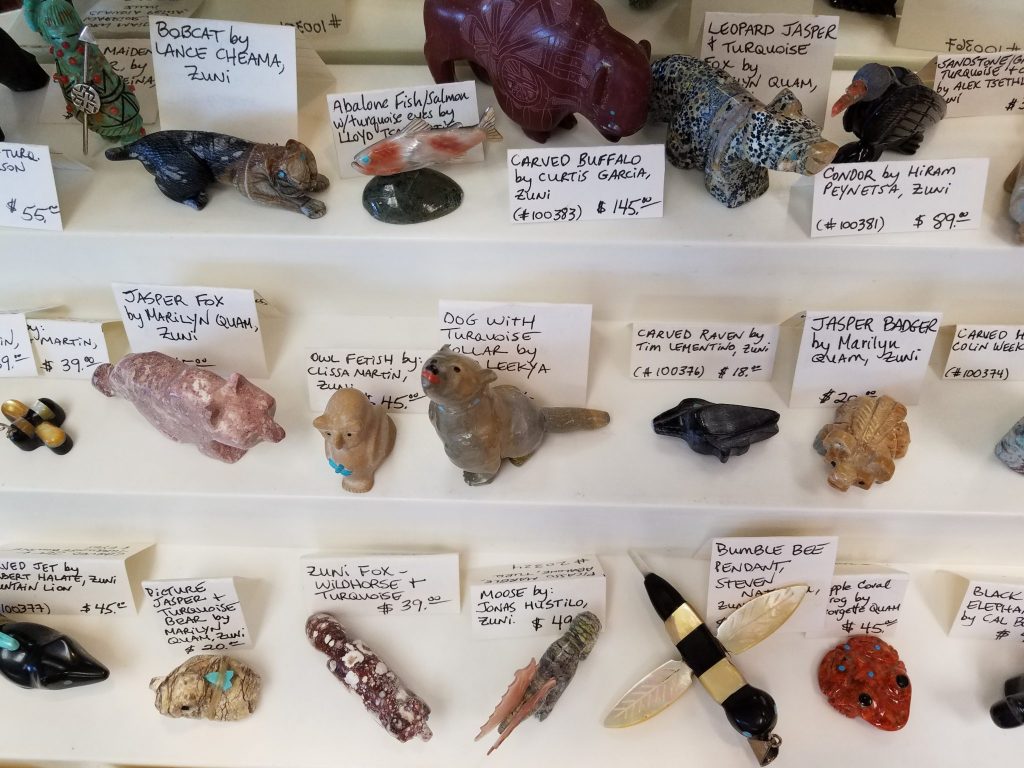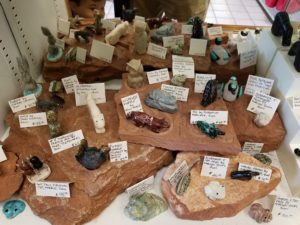COMPARE OUR PRICES OF THESE AUTHENTIC ZUNI FETISHES WITH ANYONE!
First of all, Zuni fetishes are small carvings made from various materials by the Zuni people. In addition, these carvings traditionally serve a ceremonial purpose for their creators and depict animals and icons integral to their culture. Also, they are a form of contemporary Native American art.
Traditional description
Above all, the main source for academic information on Zuni fetishes is the Second Annual Report of the Bureau of Ethnology. In addition, Frank Hamilton Cushing submits this report in 1881. Most notably, it is in publication posthumously as Zuni Fetishes in 1966, with several later reprints.
Most importantly, Cushing reports that the Zuni divide the world into six regions or directions. Accordingly, these directions include: north, west, south, east, above, and below. As a matter of fact, at the center of each region is a great mountain peak that is a very sacred place. Most significant, Yellow mountain is to the north, blue mountain is to the west. In addition, red mountain is to the south, white mountain is to the east. Also, the multi-color mountain is above, and the black mountain is below.
Most importantly, each direction represents a Prey God, or guardian animal, and are as follows:
-
In the first place, North represents the yellow mountain lion
-
Secondly, West represents the black bear (the color blue),
-
Thirdly, South represents the red badger,
-
Fourthly, East represents the white wolf,
-
Additionally, above or the sky represents the multi-colored eagle
-
Finally, below or underground represents the black mole.
Most noteworthy, each prey god is the “guardian and master” of their region. Consequently, the yellow mountain lion is the elder brother of all animals and the master and guardian of all regions. In the same fashion, each one of these regions contains an order of all the guardian animals. However the “guardian and master” of a particular region is the elder brother to all animals of that region. Equally, these guardians have protective and healing powers. Additionally, they are held by the priests of the medicine orders as if “in captivity” and act as mediators between the priests and the animals they represent.
In contrast, a second group of fetishes, the Prey Gods of the Hunt, belonging to the Hunter Order, or Society, are given in the “prayer songs of theSa-ni-a-kia-kwe”. Consequently, these guardian animals are the same as the original regions. Most notably, there is the exception of the coyote, which replaces the bear; and the wildcat (or bobcat), which replaces the red badger (Cushing, 1994:20). Finally, Sa-ni-a-kia is the awakening of the fetish and subsequently the power of the hunter (Cushing, 1994:15).
In addition, typical traditional Zuni fetishes depict animals such as the wolf, badger, bear, mountain lion, eagle, mole, frog, deer, ram, and others. In contrast, modern carvers may produce images of non-traditional subjects. Surprisingly, dinosaurs, for example, or some insects and reptiles that are traditional but more integral to petroglyphs, symbolism, and the patterns of design in pottery. Furthermore, dragonflies, butterflies, water spiders, and lizards are examples (see Bunzel, 1929; Young, 1988). Most importantly, other animals, such as the horse, are mainly for trade. Notably, the Zuni is not a horse culture, but they think of their horse carvings of the horse cultures to the North. Consequently, they have great power to protect their herds (Cushing, 1994, Bahti’s Introduction).
Materials
Traditionally, the materials of carvers are often indigenous to the region or appear by trade. Notably, the most important of these materials is turquoise, which the Zuni regard as the sacred stone. Jet, shell (primarily mother-of-pearl), and coral are also frequently in use.
Consequently, these materials, and their associated colors, are principle in the Zuni Sunface. Accordingly, Sunface is a cultural symbol which is present in Zuni jewelry and fetishes and represents their sun father. In like manner, other materials are travertine or “Zuni rock”, fish rock, jasper, pipestone, marble, or organic items such as fossilized ivory, bone, and deer or elk antler. Even artificial substances such as slag glass are used. Furthermore, the historically popular stone has been serpentine, a local soft stone found abundantly in the Zuni Mountains and also in Arizona.
Sacredness
To put it differently, each animal is believed to have inherent powers or qualities that may aid the owner. For example, the Navajo treasure and barter for figures of horses, sheep, cattle or goats to protect their herd from disease and to ensure fertility (Cushing, 1994, Bahti’s Introduction). In addition, the Zuni hunter, or “Prey brother,” is to have his fetishes (prey gods of the hunt) with a “Keeper.”
Further, they practice a ceremony of worship when procuring a favorite or proper fetish to aid in a successful hunt. Furthermore, in the ceremony of the hunt, the Keeper presents a clay pot containing the fetishes to the hunter. Namely, facing in the direction appropriate to the chosen fetish, there is sprinkling of medicine meal to the pot and they say a prayer. Most notably, the hunter places a buckskin bag, with the fetish, over his heart. (Cushing, 1994:33). Finally, the fetish aids in the chase and represents “the roar of the animal” and is also feeds on the blood of the slain prey.
In other words, there are the Prey Gods of the Six Regions, and the Prey Gods of the Hunt that aid in the chase. Beyond this, Cushing names three Prey Gods of the Priesthood of the Bow. Most importantly, this is a society of which he is a member, that aid a Priest of the Bow when traveling in a region where the enemy may capture him. In this case, there is the mountain lion and great white bear, which belong to the “skies”, as well as a prey god of human form adorned with “flint knife-feather pinions and tail”.
In addition, an arrowhead, “emblematic of Sa-wa-ni-kia”, or the “medicine of war”, is on the back or side of either of these animals. Consequently, they prevent a warrior from being taken by surprise by his enemy. Also, an arrowhead on the belly or feet erase the tracks of the carrier so that they could not be followed by the enemy. In contrast, unlike the Prey Gods of the Hunt, these fetishes are not deposited with a keeper. Correspondingly, the Prey Gods of the Hunt feed on the blood of the slain. Finally, their ceremony involves depositing sacred flour to the four directions and reciting a prayer, and like the Prey Gods of the Six Regions they protect the carrier (Cushing, 1994:40-43).
In this case, tradition that the fetishes requires a meal of cornmeal and ground turquoise periodically. Finally, it is tradition to keep a fetishes in a clay pot.
Religion as art
To begin with, the artist’s styles are as unique as the artists themselves. Additionally, some collectors prefer a figure that is more realistic in appearance, while others prefer the more traditional styles that are intrinsic to Zuni belief. Notably, the traditional belief of the Zuni is that the least modification of the original material maintains, or heightens, the power of the fetish as a “natural concretion” (Cushing, 1994:12).
Additionally, realism in carving style is a matter relative to the beliefs of its owner. Also, the realism in contemporary carving is a product of collector request and demand. Consequently, the intent of Zuni carvers is to raise the level of their art form through participation in the world of contemporary art. Most noteworthy, it is the Zuni’s belief that carvings for sale and collection have no religious intent. For this reason some carvers prefer the term “carvings” rather than the term “fetishes” when referring to offerings for collectors.
First of all, the Zuni carver may or may not sign their fetish. To clarify, personalization by signing a piece of art traditionally violates the Zuni notion of community purpose. In addition, Anglo collectors introduce the concept of signing of artwork at the beginning of the twentieth century (c. 1915). Often, though, a Zuni carver feels that their own unique style is readily identifiable and the fetish’s style will be enough to identify the carver. Ironically, most carvers are the recipients of a family tradition. Finally, they learn their skill from parents, grand parents, or siblings, and pass the art to their own children as well.
Besides being made from various stones and other materials (each material has unique properties), the contemporary fetish may carry an offering of a smaller animal or a prayer bundle of carved arrowheads with small beads of heishe. It may be adorned with a heishe necklace, feathers, etchings representing ancient petroglyphs, or an etched or inlaidheartline. These small items, although colorful to the eye, are intended to protect and feed the fetish itself.
Portions of the preceding information provided by Wikipedia ©.
At Tucson Indian Jewelry, we sell Zuni Fetishes by artists including:
Gail Lucie
Eldred Quam
Bernard Homer
Ephran Chavez
Ed Lementino
Delvin Leekya
Abby Quam
Lorae Lonasee
Enrike Leekya
Terrance Martza
Russel Shack
Georgette Quam
Sedrick Banteah
Gloria Chattin
Ernesto Quam, Zuni Carver, showing his latest carvings at the Tucson Indian Jewelry front counter
To learn more about the Zuni Pueblo, please click HERE!
Tucson Indian Jewelry 1990 – 2022 © Schannep Ventures L.L.C. ALL RIGHTS RESERVED


